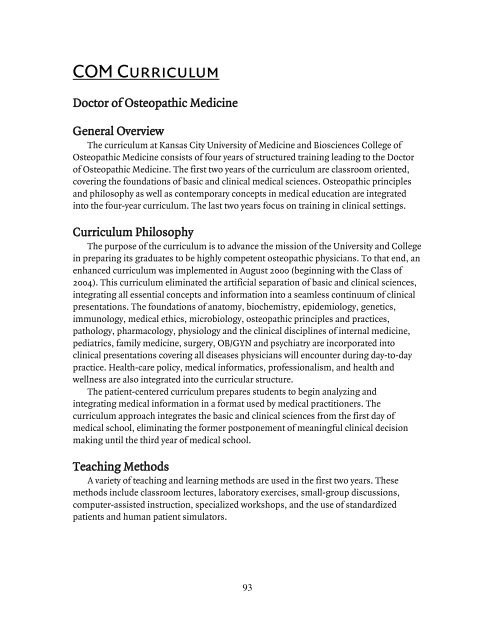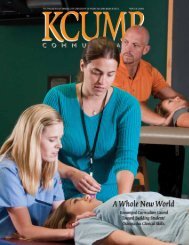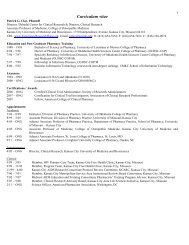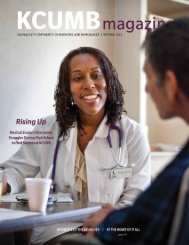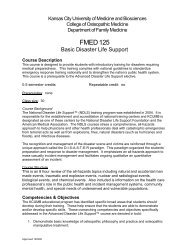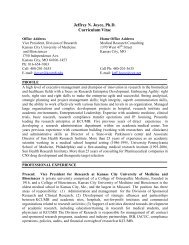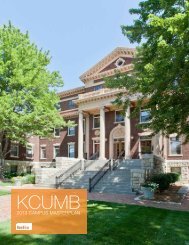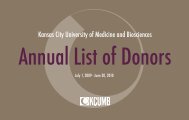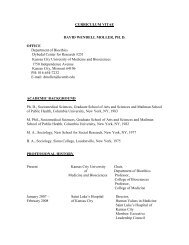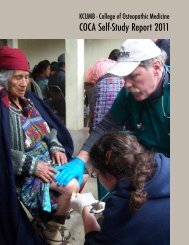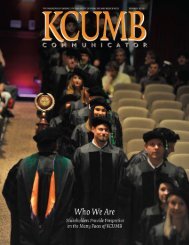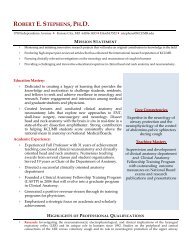2009-2010 KCUMB College Catalog - Kansas City University of ...
2009-2010 KCUMB College Catalog - Kansas City University of ...
2009-2010 KCUMB College Catalog - Kansas City University of ...
Create successful ePaper yourself
Turn your PDF publications into a flip-book with our unique Google optimized e-Paper software.
COM Curriculum<br />
Doctor <strong>of</strong> Osteopathic Medicine<br />
General Overview<br />
The curriculum at <strong>Kansas</strong> <strong>City</strong> <strong>University</strong> <strong>of</strong> Medicine and Biosciences <strong>College</strong> <strong>of</strong><br />
Osteopathic Medicine consists <strong>of</strong> four years <strong>of</strong> structured training leading to the Doctor<br />
<strong>of</strong> Osteopathic Medicine. The first two years <strong>of</strong> the curriculum are classroom oriented,<br />
covering the foundations <strong>of</strong> basic and clinical medical sciences. Osteopathic principles<br />
and philosophy as well as contemporary concepts in medical education are integrated<br />
into the four-year curriculum. The last two years focus on training in clinical settings.<br />
Curriculum Philosophy<br />
The purpose <strong>of</strong> the curriculum is to advance the mission <strong>of</strong> the <strong>University</strong> and <strong>College</strong><br />
in preparing its graduates to be highly competent osteopathic physicians. To that end, an<br />
enhanced curriculum was implemented in August 2000 (beginning with the Class <strong>of</strong><br />
2004). This curriculum eliminated the artificial separation <strong>of</strong> basic and clinical sciences,<br />
integrating all essential concepts and information into a seamless continuum <strong>of</strong> clinical<br />
presentations. The foundations <strong>of</strong> anatomy, biochemistry, epidemiology, genetics,<br />
immunology, medical ethics, microbiology, osteopathic principles and practices,<br />
pathology, pharmacology, physiology and the clinical disciplines <strong>of</strong> internal medicine,<br />
pediatrics, family medicine, surgery, OB/GYN and psychiatry are incorporated into<br />
clinical presentations covering all diseases physicians will encounter during day-to-day<br />
practice. Health-care policy, medical informatics, pr<strong>of</strong>essionalism, and health and<br />
wellness are also integrated into the curricular structure.<br />
The patient-centered curriculum prepares students to begin analyzing and<br />
integrating medical information in a format used by medical practitioners. The<br />
curriculum approach integrates the basic and clinical sciences from the first day <strong>of</strong><br />
medical school, eliminating the former postponement <strong>of</strong> meaningful clinical decision<br />
making until the third year <strong>of</strong> medical school.<br />
Teaching Methods<br />
A variety <strong>of</strong> teaching and learning methods are used in the first two years. These<br />
methods include classroom lectures, laboratory exercises, small-group discussions,<br />
computer-assisted instruction, specialized workshops, and the use <strong>of</strong> standardized<br />
patients and human patient simulators.<br />
93


